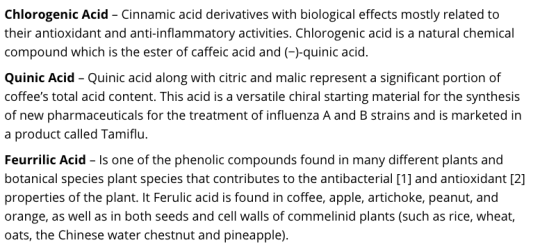Because reasons, I ended up looking at a website for a new superfood, “The Hawaiian Coffeeberry ®”. ““The Hawaiian Coffeeberry ®”, of course, isn’t a Hawaiian plant – it’s coffee, orginally from Ethiopia – but at least the marketing is Hawaiian. Well, the parts that aren’t unsourced copying from various internet sites.
Here’s a description of what they think the dominant nutrients are:

The chlorogenic acid bit is ok, though they don’t mention it’s also found in, eg, peaches, and eggplant, and potatoes.
For quinic acid, the first sentence is repeated verbatim at coffeechemistry.com. More importantly, the second sentence is a warped version of Wikipedia
This acid is a versatile chiral starting material for the synthesis of new pharmaceuticals. A medication for the treatment of influenza A and B strains called Tamiflu has been successfully developed and launched into the market.
Here it is pretty clear which is the original: the Wikipedia claim about Tamiflu is true (quinic acid was a starting material) and the “The Hawaiian Coffeeberry ®” claim is false (quinic acid is not marketed as Tamiflu).
For the third ‘nutrient’, the second spelling “ferulic acid” is the correct one. The second sentence is a very close match to Wikipedia. What’s really interesting is the first sentence, with the numbers that look like references but aren’t. Teachers will recognise free-floating reference markers as a sign of plagiarism. Teachers will also know the Google reveals all (or at least ‘most’).
There are a few places where the phrase “contributes to the antibacterial \[1\] and antioxidant \[2\] properties” appears. In those places, the full sentence is
“It is one of the phenolic compounds found in the invasive plant species carpobrotus edulis and contributes to the antibacterial\[1\] and antioxidant\[2\] properties of the plant.”
Searching on that sentence gives a Wikipedia entry, but for rutin, not for ferulic acid.
Fail.